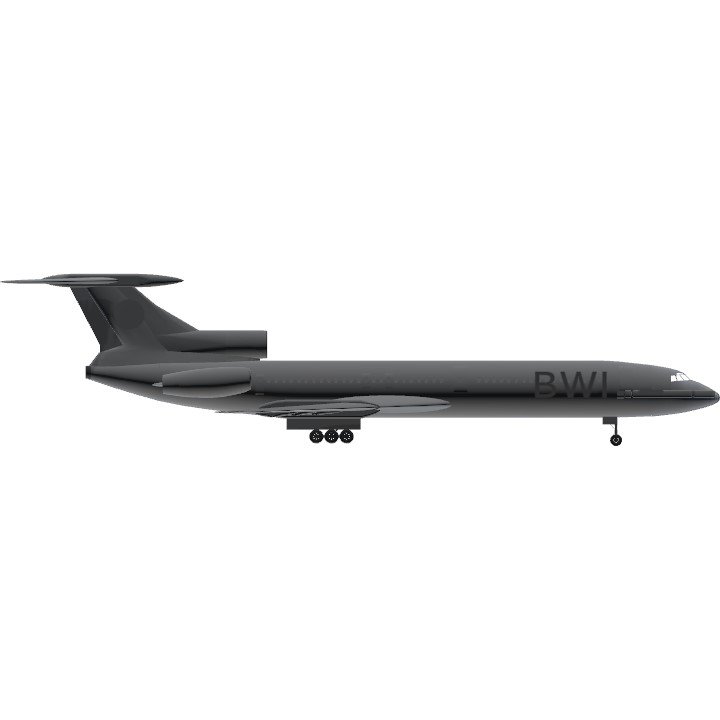brother tango charlie 2937 :)

about the plen
The Tupolev Tu-154 (Russian: Ty????? ??-154; NATO reporting name: "Careless") is a three-engined, medium-range, narrow-body airliner designed in the mid-1960s and manufactured by Tupolev. A workhorse of Soviet and (subsequently) Russian airlines for several decades, it carried half of all passengers flown by Aeroflot and its subsidiaries (137.5 million/year or 243.8 billion passenger-km in 1990), remaining the standard domestic-route airliner of Russia and former Soviet states until the mid-2000s. It was exported to 17 non-Russian airlines and used as a head-of-state transport by the air forces of several countries.
The aircraft has a cruising speed of 850 km/h (460 kn; 530 mph)[2] and a range of 5,280 kilometres (3,280 mi). Capable of operating from unpaved and gravel airfields with only basic facilities, it was widely used in the extreme Arctic conditions of Russia's northern/eastern regions, where other airliners were unable to operate. Originally designed for a 45,000-hour service life (18,000 cycles), but capable of 80,000 hours with upgrades, it was expected to continue in service until 2016, although noise regulations have restricted flights to Western Europe and other regions.
Development
Tu-154 for Russian Ministry of Defence Manufacturing, Aviakor plant, 2009, one of several airframes built in the 1990s and left unsold
The Tu-154 was developed to meet Aeroflot's requirement to replace the jet-powered Tu-104 and the Antonov An-10 and Ilyushin Il-18 turboprops. The requirements called for either a payload capacity of 16–18 tonnes (35,000–40,000 lb) with a range of 2,850–4,000 kilometres (1,540–2,160 nmi) while cruising at 900 km/h (490 kn), or a payload of 5.8 tonnes (13,000 lb) with a range of 5,800–7,000 kilometres (3,100–3,800 nmi) while cruising at 850 km/h (460 kn). A take-off distance of 2,600 metres (8,500 ft) at maximum takeoff weight was also stipulated as a requirement. Conceptually similar to the British Hawker Siddeley Trident, which first flew in 1962, and the American Boeing 727, which first flew in 1963, the medium-range Tu-154 was marketed by Tupolev at the same time as Ilyushin was marketing the long-range Ilyushin Il-62. The Soviet Ministry of Aircraft Industry chose the Tu-154, as it incorporated the latest in Soviet aircraft design and best met Aeroflot's anticipated requirements for the 1970s and 1980s.[3]
The first project chief was Sergey Yeger [ru]; in 1964, Dmitryi S. Markov [ru] assumed that position. In 1975, the project lead role was turned over to Aleksandr S. Shengardt [ru].[4]
The Tu-154 first flew on 4 October 1968. The first deliveries to Aeroflot were in 1970 with freight (mail) services beginning in May 1971 and passenger services in February 1972. Limited production of the 154M model was still occurring as of January 2009, despite previous announcements of the end of production in 2006.[5] 1025 Tu-154s have been built, 214 of which were still in service as of 14 December 2009.[6] The last serial Tu-154 was delivered to the Russian Defense Ministry on 19 February 2013[7] from the Aviakor factory, equipped with upgraded avionics, a VIP interior and a communications suite. The factory has four unfinished airframes in its inventory which can be completed if new orders are received.[8]
photo of plane

Specifications
General Characteristics
- Predecessor Tupolev Tu-154M
- Created On Windows
- Wingspan 122.3ft (37.3m)
- Length 154.7ft (47.2m)
- Height 37.0ft (11.3m)
- Empty Weight 59,254lbs (26,877kg)
- Loaded Weight 87,185lbs (39,546kg)
Performance
- Power/Weight Ratio 1.569
- Wing Loading 42.0lbs/ft2 (205.2kg/m2)
- Wing Area 2,074.2ft2 (192.7m2)
- Drag Points 51319
Parts
- Number of Parts 482
- Control Surfaces 5
- Performance Cost 2,139







@Airgaurdian i guess it will